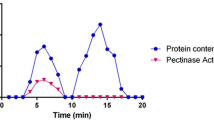Abstract
Zymogram analysis is a useful tool for the identification of several enzymes. The present study was undertaken to investigate the efficiency gains from the characterization of pectic enzymes on zymograms by staining of pectin–agarose overlays using cetyl trimethyl ammonium bromide also known as cetrimide or CTAB. The method is based on the fact that the enzymatic hydrolysis of the pectic substrates included in the agarose matrix gel inhibited their precipitation by CTAB, leading to the appearance of cleared zones in front of the pectin hydrolases and lyases. Conversely, esterases led to the increase of pectin precipitation. Fungal pectinolytic enzymes were separated on sodium dodecyl sulfate-polyacrylamide gel electrophoresis and subjected to the zymogram detection technique, using two pectin substances, namely citrus pectin and polygalacturonic acid. Overall, the findings presented in the current study indicate that several elements (ions, salts, pH, temperature, chelators, and reducing agents) may significantly affect the results of zymogram analysis and can, therefore, be employed to enhance the discriminatory and operational potential of the analysis in terms of accurate discrimination between several pectinolytic activities involved and effective implementation of the purification procedures required in the process.




Similar content being viewed by others
References
Gummadi, S. N., & Panda, T. (2003). Purification and biochemical properties of microbial pectinases: A review. Process Biochemistry, 28, 987–996.
Alkorta, I., Garbisu, C., Llama, J. M., & Sera, J. L. (1998). Industrial applications of pectic enzymes: A review. Process Biochemistry, 1, 21–28.
Naidu, G. S. N., & Panda, T. (1998). Production of pectinolytic enzymes: A review. Bioprocess Biosystems Engineering, 19, 355–361.
Hadj-Taieb, N., Ayadi, M., Trigui, S., Bouabdallah, F., & Gargouri, A. (2002). Hyperproduction of pectinase activities by a fully constitutive mutant (CT1) of Penicillium occitanis. Enzyme and Microbial Technology, 30, 662–666.
Hadj-Taieb, N., Ayadi, M., Khlif, M., Mrad, K., Hassairi, I., & Gargouri, A. (2006). Fermentor production of pectinases on gruel, a local by-product and their use in olive oil extraction. Enzyme and Microbial Technology, 39, 1072–1076.
Aguilar, C., & Huitron, C. (1987). Stimulation of production of extracellular pectinolytic activities of Aspergilus sp. by galacturonic acid and glucose addition. Enzyme and Microbial Technology, 9, 690–696.
Pitt, D. (1988). Pectin lyase from Phoma medicaginis var pinodella. In W. A. Wood & S. T. Kellogg (Eds.), Methods in enzymology (Vol. 161, pp. 350–354). San Diego: Academic.
Sakai, T. (1988). Propectinase from yeasts and yeast like fungus. In W. A. Wood & S. T. Kellogg (Eds.), Methods in enzymology (Vol. 161, pp. 337–339). San Diego: Academic.
Kawano, C. Y., Dos Santos, M. A., Chellegatti, C., Said, S., & Vieira Fonseca, M. J. (1999). Comparative study of intracellular and extracellular pectinases produced by Penicillium frequentans. Biotechnology and Applied Biochemistry, 29, 133–140.
Shobha, M. S., Vishu Kumar, A. B., Tharanathan, R. N., Rathna, K., & Antil Kumar, G. (2005). Modification of guar galactomannan with the aid of Aspergillus niger pectinase. Carbohydrate Polymers, 62(1), 267–273.
Ried, J. L., & Collmer, A. (1985). Activity stain for rapid characterization of pectic enzymes in isoelectric focusing and sodium dodecyl sulfate-polyacrylamide gels. Applied and Environmental Microbiology, 50, 615–622.
Dowin, B., Dirk, L. M. A., Hadfield, K. A., Wilkins, T. A., Bennett, A. B., & Bradford, K. J. (1998). A gel diffusion assay for quantification of pectin methylesterase activity. Analytical Biochemistry, 264, 149–157.
Gainvors, A., Frezier, V., Lemaresquier, H., Lequart, C., Aigle, M., & Belarbi, A. (1994). Detection of polygalacturonase, pectin-lyase and pectin-esterase activities in a Saccharomyces cerevisiae strain. Yeast, 10, 1311–1319.
Mandels, M., Andreotti, R., & Roche, C. (1976). Measurement of saccharifying cellulose. Biotechnol Bioeng Sym, 6, 21–33.
Miller, G. L. (1958). Use of dinitrosalicylic acid reagent for determination of reducing sugar. Analytical Chemistry, 31, 426–428.
Bradford, M. M. (1976). A rapid and sensitive method for the quantitation of microgram quantities of protein utilizing the principle of protein-dye binding. Analytical Biochemistry, 72, 248–254.
Schejter, A., & Marcus, S. L. (1988). Isozymes of pectinesterase and polygalacturonase from Botrytis cinerea Pers. In W. A. Wood & S. T. Kellogg (Eds.), Methods in enzymology (Vol. 161, pp. 350–354). San Diego: Academic.
Laemmli, U. K., & Favre, M. (1973). Maturation of the head of bacteriophage T4. I. DNA packaging events. Journal of Molecular Biology, 80, 575–599.
Damak, N., Hadj-Taieb, N., Bonnin, E., Ben Bacha, A., & Gargouri, A. (2011). Purification and biochemical characterization of a novel thermoactive fungal pectate lyase from Penicillium occitanis. Process Biochemistry, 46, 888–893.
Celestino, S. C., Maria de Freitas, S., Javier Medrano, F., Valla de sousa, M., & Ximenes Ferreira Filho, E. (2006). Purification and characterization of a novel pectinase from Acrophialophora nainiana with emphasis on its physicochemical properties. Journal of Biotechnology, 123, 33–42.
Kaur, G., Kumar, S., & Satyanarayana, T. (2004). Production, characterization and application of a thermostable polygalacturonase of a thermophilic mould Sporotrichum thermophile Apinis. Bioresource Technology, 94, 239–243.
Jayani, R. S., Saxena, S., & Gupta, R. (2005). Microbial pectinolytic enzymes. Rev Proc Biochem, 40, 2931–2944.
Acknowledgments
This work is supported by the “Ministère de l’Enseignement Supérieur et de la Recherche Scientifique”. The authors wish to express their gratitude to Prof. Anouar Smaoui from the Sfax Faculty of Science for carefully proofreading and constructively polishing the language of the current paper.
Author information
Authors and Affiliations
Corresponding author
Rights and permissions
About this article
Cite this article
Hadj-Taieb, N., Tounsi, H., Chabchoub, A. et al. Studies on the Zymogram Method for the Detection of Pectinolytic Activities Using CTAB. Appl Biochem Biotechnol 165, 1652–1660 (2011). https://doi.org/10.1007/s12010-011-9384-y
Received:
Accepted:
Published:
Issue Date:
DOI: https://doi.org/10.1007/s12010-011-9384-y




